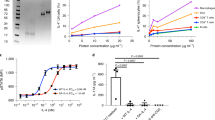Study aim. The efficacy of Russian-produced recombinant interleukin-2 (IL-2) in the complex treatment of encephalitis was studied in children. Materials and methods. A total of 40 patients aged from six months to 17 years were treated. Drug was given at a dose of 0.5 mg/day by i.v. infusion for three days in acute cases and for five days in chronic cases. The reference group consisted of 35 patients with encephalitis, treated without study drug. Results. Use of recombinant IL-2 decreased the duration of developing symptoms by 5.4 ± 1.3 days, decreased neurological deficit on the EDSS on discharge from hospital by 1.6 ± 0.2 points, and decreased the frequency of acute exacerbations from 22.9% to 5% and the frequency of developing multiple sclerosis over three years from 17.1% to 2.5% (p ≤ 0.05). Efficacy correlated with positive changes in immunological parameters 3–4 weeks after treatment ended. Studies of multimodal evoked potentials in the brain during use of this drug showed that it had positive influences on the central afferent conduction time. There was a reduction in the proportion of patients with focal changes on follow-up MRI scans. Conclusions. Recombinant IL-2 is recommended for the treatment of children with encephalitis.
Similar content being viewed by others
References
N. V. Skripchenko and G. P. Ivanova, “Neuroinfections in pediatric practice,” Proc. 18th Russ. Nat. Congr. Humans and Medicines: Lectures for Practicing Doctors, Moscow, April 11–15, 2011, Moscow (2012), pp. 607–642.
N. V. Skripchenko, G. P. Ivanova, T. N. Trofimova, and V. N. Komantsev, “Multiple sclerosis and neuroinfections: causal relationships in children,” Proc. 7th All-Russ. Sci. Appl. Conf. Health – the Basis of Human Potential. Problems and Pathways to their Solution, St. Petersburg (2012), Vol. 7, Pt. 2, pp. 795–797.
G. P. Ivanova, Leukoencephalitis in Children (differential diagnostic, pathogenetic, and therapeutic aspects): Auth. Abstr. Dissert. Doct. Med. Sci., St. Petersburg (2012).
N. V. Skripchenko, Clinical Experience in the Use of Roncoleukin (recombinant Interleukin-2) in Infectious Diseases in Children: Notes for Doctors, Yu. V. Lobzin (ed.), Alter-Ego, St. Petersburg (2010).
G. P. Ivanova, N. V. Skripchenko, G. F. Zheleznikova, and N. E. Monakhova, “The scientific basis for the use of recombinant IL-2 in leukoencephalitis in children,” Proc. All-Russ. Ann. Conf. Infectious Diseases in Children: Diagnosis, Treatment, and Prophylaxis, Sept. 17–18, 2012, Infektologiya (Suppl.), 4, No. 4, 70 (2012).
N. V. Skripchenko, Assessment of the Efficacy of Roncoleukin in the Treatment of Neuroinfections in Children: Report of the Research Institute of Childhood Infections, St. Petersburg (2009).
G. F. Zheleznikova, N. V. Skripchenko, V. V. Ivanova, et al., “Immunology of viral infections in children: notes,” Current Approaches to the Diagnosis, Treatment, and Prophylaxis of Infectious Diseases in Children: Coll. Sci. Studies for the 85th Anniv. of the Research Institute of Childhood Infections, Yu. V. Lobzin (ed.), St. Petersburg (2012), Vol. II, pp. 71–110.
G. F. Zheleznikova and N. V. Skripchenko, “Immunopathogenesis of infectious-inflammatory diseases of the central nervous system,” Infektologiya, 3, No. 2, 28–32 (2011).
N. V. Skripchenko, G. P. Ivanova, G. F. Zheleznikova, et al., “Pathogenetic aspects of the treatment and outcomes of leukoencephalitis in children,” Neirokhirurg. Nevrol. Detsk. Vozrasta, No. 2–3, 58–69 (2012).
G. P. Ivanova, N. V. Skripchenko, G. F. Zheleznikova, and N. E. Monakhova, “Features of immune protection in leukoencephalitis in children,” Ross. Vestn. Perinatol. Pediatr., 57, No. 3, 56–64 (2012).
S. A. Ketlinskii and A. S. Simbirtsev, Cytokines, Foliant Press, St. Petersburg (2008).
Y. Ruth, C. Selmi, E. Gershwin, “The regulatory, inflammatory, and T cell programming roles of interleukin-2 (IL-2),” J. Autoimmunity, 31, 7–12 (2008).
V. I. Kozanidou, A. D. Theocharis, A. Georgiadis, et al., “Signal transduction by IL-2 and its receptors as target in treatment of rheumatoid arthritis,” Curr. Drug Targets Immune Endocr. Metabol. Disord., 5, 41–50 (2005).
Y. G. You, H. S. Wang, J. H. Yang, et al., “Transfection of IL-2 and/or IL-12 genes into spleen in treatment of rat liver cancer,” World J. Gastroenterol., 10, 2190–2194 (2004).
Author information
Authors and Affiliations
Corresponding author
Additional information
Translated from Zhurnal Nevrologii i Psikhiatrii imeni S. S. Korsakova, Vol. 114, No. 5, Iss. I, pp. 27–32, May, 2014.
Rights and permissions
About this article
Cite this article
Skripchenko, N.V., Ivanova, G.P., Zheleznikova, G.F. et al. Experience in the Use of Recombinant Interleukin-2 in the Treatment of Children with Encephalitis. Neurosci Behav Physi 45, 1095–1100 (2015). https://doi.org/10.1007/s11055-015-0191-8
Published:
Issue Date:
DOI: https://doi.org/10.1007/s11055-015-0191-8




